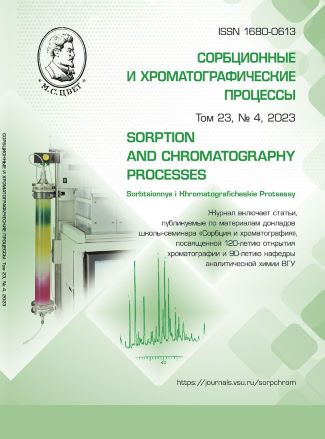Adsorption properties of a surface-layer adsorbent based on wide-pore SiO2 and metal-organic framework polymer MIL-100(Cr) in relation to volatile organic compounds of different classes
Abstract
The study of the adsorption and selective properties of the composite surface-layer adsorbent SiO2/MIL-100(Cr) was performed using the inverse gas chromatography method. The composite was prepared on the basis of silicon dioxide and MIL-100(Cr) – benzene-1,3,5-tricarboxylate Cr(III), which is a mesoporous metal-organic coordination polymer (MOCP). The textural characteristics of the original MIL-100(Cr) and the composite with it were determined using the method of low-temperature nitrogen adsorption/desorption. A sharp decrease in the specific surface area of the composite compared to the synthesized MOCP was established, which is explained by the low mass content of the latter (15 %) relative to the silica support. Based on experimental data, the thermodynamic characteristics of the adsorption of various hydrocarbons and chlorinated methane derivatives on a surface-layer adsorbent were calculated. An analysis of the specific retention volumes and thermodynamic characteristics of adsorption demonstrated that the composite adsorbent exhibits a mixed adsorption mechanism. Depending on the nature of the adsorbate and the shape and size of its molecule, various types of intermolecular interactions appear, and a sieve effect was also observed. Using cyclohexane as an example, the possibility of the passage of its molecules only into the pores of one type of framework due to the discrepancy between the dimensions of the pore window was demonstrated. It is proposed to consider the interaction of adsorbate molecules with the porous structure of MIL-100(Cr) in the framework of “guest-host” complex formation by analogy with macrocyclic compounds. Surface layer adsorbent SiO2/MIL-100(Cr) exhibited selective properties towards isomeric alkanes and arenes. Separation factor for isomeric octanes at 160 ℃ was 1.4 for the 2,3,4-trimethylpentane/2,2,4-trimethylpentane pair and 1.5 for the 2,3-dimethylhexane/2,2,4-trimethylpentane pair. In the case of xylene isomers, the highest separation factor was observed for o- and m-xylenes (αo/m = 1.2).
Downloads
References
Maselko J., Self-organization as a new method for synthesizing smart and structured materials, Materials Science and Engineering: C, 1996; 4(3): 199-204. https://doi.org/10.1016/S0928-4931(96)00146-4
Drain C.M., Self-organization of self-assembled photonicmaterials into functional devices: Photo-switched conductors, PNAS, 2002; 99(8): 5178-5182. https://doi.org/10.1073/pnas.062635099
Hosono N., Kitagawa S., Modular Design of Porous Soft Materials via Self-Organization of Metal-Organic Cages, Acc. Chem. Res., 2018; 51(10): 2437-2446. https://doi.org/10.1021/acs.accounts.8b00361
Wang J., Huang M.J., Baker-Sediako R.D., Kapral R., Aranson I.S., Forces that control self-organization of chemically-propelled Janus tori, Commun. Phys., 2022; 5(176). https://doi.org/10.1038/s42005-022-00953-9
Kato H., Noh J., Hara M., Kawai M., An HREELS Study of Alkanethiol Self-Assembled Monolayers on Au(111), J. Phys. Chem. C, 2002; 106(37): 9655-9658. https://doi.org/10.1021/jp020968c
Onuchak L.A., Lapshin S.V., Kudryashov S.Yu., Akopova O.B., Adsorption and selective retention of organic compounds by graphitized thermal black modified with a nematic crown ether, Russ. J. Phys. Chem. A., 2005; 79(5): 817-819
Innocenzi P., Mesoporous ordered films via self-assembly: trends and perspectives, Chem. Sci., 2022; 13: 13264-13279. https://doi.org/10.1039/D2SC04828K.
Babutan I., Todor-Boer O., Atanase L.I., Vulpoi A., Botiz I., Self-Assembly of Block Copolymers in Thin Films Swollen-Rich in Solvent Vapors, Polymers, 2023; 15(8): 1900. https://doi.org/10.3390/polym15081900
Kotova A.A., Thiebaut D., Vial J., Tissot A., Serre C., Metal-organic frameworks as stationary phases for chromatography and solid phase extraction: A review, Coord. Chem. Rev., 2022; 455: 214364. https://doi.org/10.1016/j.ccr.2021.214364
Tian Y., Zhu G., Porous Aromatic Frameworks (PAFs), Chem. Rev., 2020; 120(16): 8934-8986. https://doi.org/10.1021/acs.chemrev.9b00687
Freund R., Zaremba O., Arnauts G., Ameloot R., Skorupskii G., Dincă M., Bavykina A., Gascon J., Ejsmont A., Gościańska J., Kalmutzki M., Lächelt U., Ploetz E., Diercks C., Wuttke S., The Current Status of MOF and COF Applications, Angew. Chem. Int. Ed., 2021; https://doi.org/10.1002/anie.202106259
Dodziuk H. Cyclodextrins and their complexes. Weinheim, Wiley-VCH, 2006, 507 p.
Cserhati T., Forgacs E. Cyclodextrins in chromatography. Cambridge, RSC, 2003, 158 p.
Yusuf V.F., Malek N.I., Kailasa S.K., Review on Metal-Organic Framework Classification, Synthetic Approaches, and Influencing Factors: Applications in Energy, Drug Delivery, and Wastewater Treatment, ACS Omega, 2022; 7(49): 44507-44531. https://doi.org/10.1021/acsomega.2c05310
Onuchak L.A., Kopytin K.A., Kuraeva Y.G., Pariichuk M.Yu., Martina Y.V., Vinogradov N.A., Alexandrov E.V. Adsorption properties and gas chromatographic application of a composite surface-layer sorbent with Terephthalic acid-based metal-organic framework, J. Chromatogr. A., 2022; 1679: https://doi.org/10.1016/j.chroma.2022.463373.
Kudryashov S.Yu., Arutyunov Yu.I., Onuchak L.A., New methods for determining the volumetric flow rate in the column and the retention time of the unretained substance in gas chromatography, Russ. J. Phys. Chem. A., 2007; 81(1) 102-107.
Férey G., Serre C., Mellot-Draznieks C., Millange F., Surble S., Dutour J., Margiolaki I., A Hybrid Solid with Giant Pores Prepared by a Combination of Targeted Chemistry, Simulation, and Powder Diffraction, Angew. Chem. Int. Ed., 2004; 43: 6296-6301. https://doi.org/10.1002/anie.200460592
Chen M.-L., Zhou S.-Y., Xu Z., Ding L., Cheng Y.-H., Metal-Organic Frameworks of MIL-100(Fe, Cr) and MIL-101(Cr) for Aromatic Amines Adsorption from Aqueous Solutions, Molecules, 2019; 24: 3718. https://doi.org/10.3390/molecules24203718
Zhong G., Liu D., Zhang J., Applications of Porous Metal-Organic Framework MIL-100(M=Cr,Fe,Sc,Al,V), Cryst. Growth Des., 2018; 18: 12 7730-7744. https://doi.org/10.1021/acs.cgd.8b01353
Kiselev A.V. Mezhmolekuljarnye vzaimodejstvija v adsorbcii i hromatografii. M., Vyssh. shk., 1986, 360 p. (In Russ.)
Tugareva D.A., Onuchak L.A., Kapralova T.S., Kuraeva Yu.G., Kuvshinova S.A., Burmistrov V.A., Sorbtsionnoe pereraspredelenie uglevodorodov i spirtov v sisteme gaz – supramolekulyarnyi zhidkii kristall 4-(2-gidroksietoksi)-4’-tsianoazoksibenzol, Zhidkie kristally i ikh prakticheskoe ispol'zovanie, 2015; 15(1): 81-90. (In Russ.)
Kudryashov S.Yu., Kopytin K.A., Pavlov M.Yu., Onuchak L.A., Kuraeva Yu.G., Adsorption of organic vapors on the carbopack y carbon adsorbent modified with heptakis-(2,3,6-tri-О-methyl)-β-cyclodextrin, Russ. J. Phys Chem. A., 2010; 84(3): 495-502.







